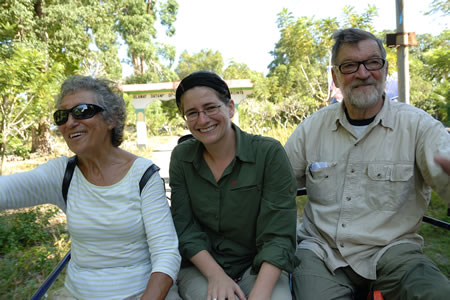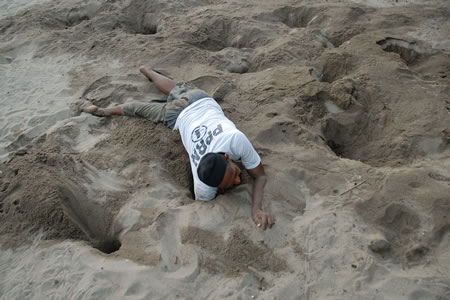

| On the way with the Sparrow doctor | |
Ambon (Indonesia), April 4th 2009 |
|
The Moluccan Scrubfowl or Wallace’s Megapode (Megapodius Wallacei) is one of the rarest birds in the world. This bird, which is high on the target list of many bird watchers, is still a relatively unknown bird. We were very lucky to run into Dr. Kees Heij and his wife in the Moluccan city of Ambon, in Indonesia. Kees, also known in The Netherlands as the Sparrow Doctor because of his doctoral thesis on the House Sparrow, is one of the world specialists on the Moluccan Scrubfowl. The special thing about this bird is that the eggs are not hatched by the bird itself, but by the warmth of mother earth. The female birds travel back to their birth grounds ten times a year to lay their eggs. The Moluccan Archipelago is one of the places on earth where you can still see this special bird. Infected by the enthusiasm of Kees, we decided to join him for the short journey to the remote island of Haruku where some of the nesting grounds are located. Kees lived in the village of Kailolo on Haruku more than a decade ago to do research to the breeding activities of the Moluccan Scrubfowl. Every year he travels back to this small village to see what the status is of the bird population. The population has difficult times because the local people are collecting the eggs fanatically, to sell them on the local market. The collecting rights of the eggs are every year sold by the local community to the person with the highest offer. The person who acquires the rights, gets the exclusive collecting rights for a whole year for the nesting grounds of Kailolo. For coming year, Kees managed to buy the rights in collaboration with a local straw man. The deal is that Kees pays for the rights and that the straw man is allowed collect the eggs ‘lazily’. The idea is that less eggs are collected which means that more eggs are hatched. And that is good for the population. |
|
 |
|
Dr. Kees Heij and his wife Lydi are welcomed in Kailolo on the island of Haruku |
|
At eight o’clock in the morning we take a bemo (small local bus) from Kota Ambon to the small harbour village of Teluhu. From there we take a small boat for the twenty minutes crossing to Kailolo on the island of Haruku. When we arrive on the beach of Kailolo, Pak Pede, the straw man, is already waiting for us. “Pak” (best translated to Father) is a respectful title for middle-aged men. The beach of Kailolo is like many other village beaches in this part of the world. Many people, especially men, hang around doing nothing. Most of them sit in the shade of the trees or are playing cards, watching the activities going on on the beach. We step in the small cargo hold of Pak Pede’s motorcycle and make the short ride into the village. Soon we notice that Kees is a respected guest in the village. When the villagers see Kees, they start smiling and waving, and greet him with the words: “Hello Pak Kees!”. A lost son has returned to the village. When we arrive at Pak Pede’s house, we are warmly welcomed by his family. Quickly afterwards we sit down to table for a nice local meal. During the lunch we decide to spend also the night on the nesting grounds of the Moluccan Scrubfowl. It is the only chance to see this special bird, because it is only present at night to lay its egg. If everything goes well, the birds leave the nesting grounds before the sun sets, so it is extremely difficult to see them during daylight. We use the remaining part of the day to explore the area around Kailolo. We visit a mangrove forest, and make a short stroll through the spice plantations. For the first time in our life we see the nutmeg and clove trees. A local small girl climbs in the tree for us to pick some of the fruits. Ambon was one of the spice islands that were gold mines for the colonial powers in the past. Nowadays the plantations are used for the benefit of the local communities. But our main reason to come to Haruku is to see the Moluccan Scrubfowl, so we can’t wait till the evening falls. |
|
 |
|
The collecting shift in search of the eggs of the Moluccan Scrubfowl |
|
| The nesting grounds of the Moluccan Scrubfowl consist of several small sandy spots (beach sand) in a forest near the sea. We sit down at the edge of one of the spots around nine o’clock in the evening, in anticipation of the birds. We have no sleeping mattresses, so we take a seat on the warm and dry beach sand. The waiting can begin. Our patience is rewarded soon afterwards. We hear the first birds arrive in the trees around the sandy spot. Several minutes later the first birds ‘fall’ from the tree on the sandy spot, in search for a good place to lay their egg. The moon is half full which means that the light in not optimal, but it is good enough to see the contours of the birds. Most of the birds grub around for a while before they start digging the hole in where they want to lay the eggs. Sometimes they stop digging because the spot is not suitable enough. In that case they start looking for a different spot. After the egg is laid, the Moluccan Scrubfowl fills up the hole again and flies back to the nearby island of Seram where they spend the days. We stay the whole night at the nesting ground to observe the birds. Once in a while we lay down for an hour or so to take a short nap.
Early in the morning, just after sunrise, the collecting shift arrives at the nesting grounds. We shake the sand out of our hair and clothes and see that the nesting grounds are partly ploughed by the hard-working birds, in search of the perfect hatching spots. The experienced collecting shift knows exactly which holes contain eggs and which not. They collect on average a hundred eggs per day. A part of the eggs are not found, and those eggs hopefully will deliver the new birds. After on average seventy-eight days, a chick is born and it takes three to four days for the chick to find its way up to the surface. When it finally arrives at the surface, it can immediately fly and the new Moluccan Scrubfowl only leaves a small hole in the ground as evidence of its birth. We had a great and interesting day and night at the nesting grounds of the Moluccan Scrubfowl in the village of Kailolo. It is amazing to see that people like Kees are enthusiastically working on the survival of threatened animals, like this special bird. Hopefully, these kinds of activities will eventually help some species to survive, not only for the animals itself, but also for our future generations. © copyright - Babakoto.eu / 2009 |
|